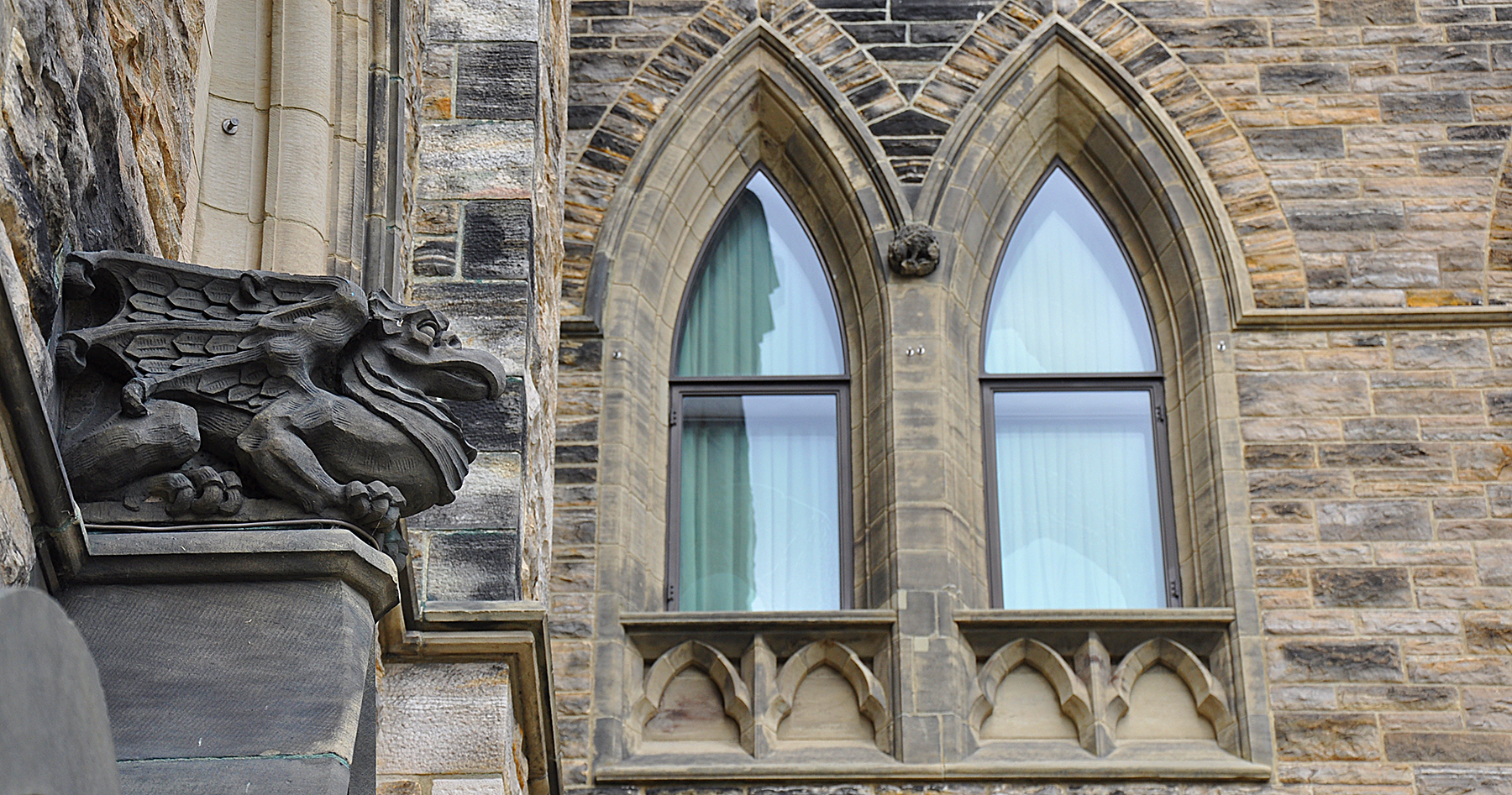Lurkers in the Shadows: Parliament’s supernatural creatures, part two

In the second of a series of four articles, we look at three supernatural creatures you’ll encounter in Parliament Hill’s Centre Block.
In February 2019, the Senate moved to the Senate of Canada Building, a former train station built in 1912. The Senate will occupy this temporary location while Parliament’s Centre Block — the Senate’s permanent home — is rehabilitated.
Although Centre Block is shuttered for rehabilitation work, Canadians can still experience its art and architecture — as well as the Senate of Canada Building’s — through the Senate’s immersive virtual tours.
Grotesques, Green Men and chimeras: before they came to roost on Parliament Hill 160 years ago, these bizarre creatures were mainstays of medieval Europe’s abbeys, cathedrals and guild halls.
They seem quirky — even charming — today, but they were once truly terrifying. To medieval churchgoers, they were the lurkers in the shadows, the phantoms that lured you off the forest path, the gremlins who blighted your crops. Scowling from the parapets of the parish chapel, they illustrated the perils of straying from the church’s teachings.
“This medieval desire to scare people silly was about teaching,” House of Commons Curator Johanna Mizgala explained. “Think about ancient fairy tales; they’re quite terrifying because they’re cautionary tales.”
The Middle Ages came back into vogue in the 1800s, spawning the Romantic movement and its dark offspring, Gothic fiction. Victor Hugo’s The Hunchback of Notre Dame, Bram Stoker’s Dracula and Mary Shelley’s Frankenstein, alongside other horror classics, tapped into the public’s insatiable appetite for shadowy villains and melancholy heroines, bleak landscapes and ruined abbeys, the supernatural and the occult.
Architects took notice. They began designing buildings in the spirit of this reawakened Gothic aesthetic, with the menacing towers, frowning battlements and misshapen creatures that populated the literature.
Parliament Hill’s trio of buildings took shape in the 1860s, at the height of this Gothic Revival movement, with grotesques taking centre stage. Unlike their medieval predecessors, however, these creatures were not there to intimidate onlookers. They were there to convey a subtle message about the role of Parliament.
“They’re signposts,” Ms. Mizgala said. “They’re tangible reminders of the principles that should guide you as you walk these halls and participate in the important work of this place.”
Meet these mystifying characters:

Green Man
An enigmatic carved face, with foliage sprouting from its eyes, mouth, nose and ears, appeared on Roman temples as early as the second century A.D. In the Middle Ages, it began springing up on churches and manor houses across northern Europe. In the 1800s, it spread to the New World, cropping up on town halls, university buildings and legislatures, including Canada’s Parliament Buildings.
For centuries, the character remained nameless. Then, in 1939, British folklorist Lady Julia Hamilton Raglan coined the term “Green Man” to refer to this mysterious figure that appeared, with only slight variations, on thousands of churches across Europe.
So, who is this Green Man? Some scholars equate him with pagan nature deities such as the Roman Silvanus or the Celtic Cernunnos, others with sprites such as Robin Goodfellow, Peter Pan or Shakespeare’s Puck. Some identify him with the Green Knight of Arthurian legend or the medieval Woodwose, personifications of nature in all its brooding menace.
Perhaps it’s impossible to pin him down because the Green Man is essentially a template on which each generation stamps its ideas about nature and humanity’s troubled relationship with it. As a consequence, the character never stops evolving.
“The invitation for the coronation of King Charles III featured a Green Man as the main design,” Ms. Mizgala pointed out. “In a way, it proclaimed a Green Man for the 21st century — a symbol of the environmental movement.”

Grotesque
Parliament Hill’s grotesques were inspired by carvings on medieval cathedrals: bat-winged vampires, steely-eyed ogres and vulture-headed demons perched high in the building’s framework.
These creatures have served as symbolic gatekeepers for centuries. Stationed near windows and entrances, the belief was that they performed a kind of “apotropaic” — or protective — magic, warding off evil spirits by confronting them face-to-face.
But it’s not all about unwavering vigilance. Out of plain view, tucked away among the rafters and darkest recesses of the building, grotesques are free to be rude, rowdy and irreverent, serving up snide social commentary that the church fathers would never allow out in the open.
On Parliament Hill, grotesques are often flights of pure whimsy, opportunities for the sculptors who carved them decades ago to unleash their creativity.
“The business of the institution is serious,” Ms. Mizgala noted. “But the message can’t always be serious. There has to be some opportunity, visually, for surprise and delight.”

Chimera
A chimera is a hybrid, a fusion of different animals. There are dozens of them on Parliament Hill, some drawn from ancient folklore, some straight from the sculptor’s imagination.
The original chimera, in Greek mythology, was a fire-breathing monster with the body of a lion, the heads of both a lion and a goat, and a tail that ended in a snake’s head.
The name “chimera” eventually came to refer to hybrids of every imaginable description. Medieval monks were so taken with the possibilities that they catalogued dozens of them in lavishly illustrated compendiums called bestiaries. Among them were the wyvern, a long-tailed, two-legged dragon; the cockatrice, a rooster-headed dragon with a deadly gaze; and the griffin, a winged lion with an eagle’s head.
The chimera of ancient mythology was the embodiment of anarchy — nature corrupted and distorted beyond recognition and a threat to everyone around it. Its motley descendants, captured in the stonework of Parliament Hill, now offer symbolic protection — just as Parliament offers institutional protection — against lawlessness and the breakdown of civil order.










